
Following up on my previous post about the Top 10 good ideas in Civilization V, here is a list of the opposite: the flaws and annoyances in the game's design that really grind my gears and make me nostalgic for the older games and wishing for dramatic changes in future sequels.
And since I'm always eager to provide constructive criticism where I can, I will propose ideas for addressing some of the problems with these features where relevant. The hope is that future games in the series will be able to learn from Civ V failures and successes and be better games.
Of course, any list of "good ideas" or "bad ideas" is going to be subjective. You may not agree with my opinions, and that's OK. If there's any features, mechanics, or design decisions that you really hate in Civilization V, its DLC, or its two expansions, please feel free to leave a comment!
Can't raze capitals
I understand why this had to happen for gameplay reasons. The [relatively] radical gameplay change to a hex-based map with tactical, 1-unit-per-tile combat meant that a lot of other features and mechanics had to be simplified - either because the developers didn't want to overwhelm players with complicated micro-systems to go with their [relatively] complicated unit-management; or because they simply didn't have the time in design and development to implement more complicated gameplay subsystems. In any case, many areas of the game, from economy, to city management, to government policies, to the tech tree, and even the victory conditions were simplified.
The more simplistic domination victory condition requires that capitals can't be razed. Being able to raze a capital would make it impossible for the capital to be recovered, and thus make it impossible for that player to win the game. And requiring the complete annihilation of every rival civ would have introduced significantly more tedium to the game. The late game already feels like a grind as is, due to the large number of units that have to be moved one at a time across the map. Having to scour the map for every snowball ice city and island city that the A.I. has founded would result in a lot more unfinished games.
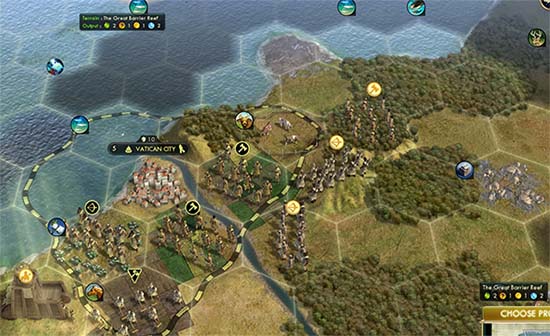
I can't raze the city and build one that can work both halves of the Great Barrier Reef.
But not being able to raze capitals resulted in some very annoying qualities of the game. For one thing, city states count as capital cities, so you can't raze them. Again, this is critical to the diplomatic victory, so it makes sense. But city states take up a huge amount of space, and they often spawn in inconvenient locations. See a city state that owns primo real estate, but it's one tile out of range of a valuable resource, or one tile away from a coast or river, or otherwise in a sub-optimal location? Argh! Same goes for other player's capitals.
On top of that, from a historical theme perspective, capital cities were frequently razed in real life. While some ancient capitals like Rome and Athens still exist, many other do not, and the significant infrastructures and wonders within them have been lost to time. This can't happen in Civ V. Wonders built in capitals are impervious to destruction, especially the annoying ones like the Great Wall.
The Instant Heal
This one isn't so much a design flaw as it is a pet peeve. You expect to kill an enemy unit in an attack, but it survives with like 3 HP because of the damned RNG, but you don't have any other units to finish it off. Argh! Then it insta-heals and kills your unit. Double Argh!! For me, this is Civ V's equivalent of that spearman killing your tank in Civ III, or losing a 99% battle in Civ IV.
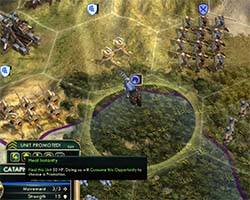
An unfortunate (and annoying)
turn of events for my opponent.
And it wouldn't be so bad if the insta-heal mechanics just worked differently. The source of my frustration is that you can insta-heal and attack on the same turn. I wouldn't mind so much if using the insta-heal counted as [all] the unit's action(s), thus preventing it from being able to attack or pillage on the same turn.
At best, the unit should be able to heal and run away. It could save itself, run away, and heal, then come back and be a problem later. But it shouldn't be able to suddenly go from critical condition to having more than half its HP and killing the other unit.
I would like the insta-heal a bit more if it was a handicap mechanic that allows weaker civs to better defend against aggression from a militarily-superior foe. But it works the opposite. The civs that focus on military, taking policies or having powers that increase unit experience accumulation or reduce promotion cost, are the ones that most benefit from this feature. Usually, it isn't a defending underdog that takes advantage of an insta-heal to repel a superior invader and turn the tide of a war. It's an overpowered invader who already has highly-promoted units and accelerated promotion acquisition who uses it to more quickly crush a weaker foe. Unit upgrades: The lonely Chariot and the schizophrenic Lancer
There have been many discussions on Civfanatics and the 2K forums regarding the Chariot and Lancer units, and how much most people hate them or don't use them. The problem isn't with the units themselves; they're fine units. The problem is their place in the tech tree and the upgrade paths that they belong to.
The Chariot Archer is actually a really good unit in the beginning of the game. It's fast and strong. It's a great defensive tool, since it can move around within your borders rapidly to defend from threats coming from any front - even without a meaningful road network. And it can be a great unit for quickly moving to and taking out barbarian encampments to gain some quick and easy city state influence.
The problem is that the unit is quickly outmatched, and it upgrades to the melee Knight, instead of another ranged unit. This upgrade means that any ranged promotions that you may have taken with your Chariot becomes mostly null and void, and your formerly elite unit now has to grind to gain useful promotions. Unless, of course, you're the Mongols or Arabia.
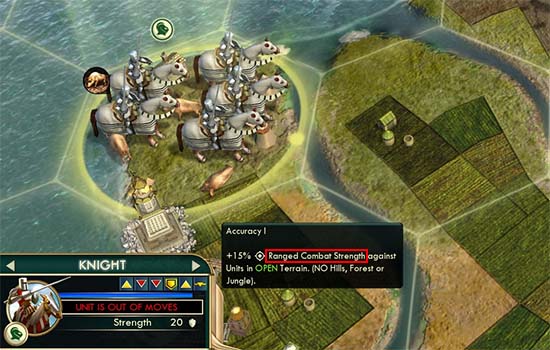
Since there isn't a full line of ranged mounted units, the Chariot Archer loses the benefits
of its promotions when it inevitably upgrades to a melee Knight.
The Lancer has similar problems, except it's even more extreme. In vanilla Civ V, the Lancer wasn't even part of an existing upgrade path. It had to be built from scratch. And so very few people built them at all because they already had a sizeable army of Knights and no more horses. The expansions made the unit more common by making it an upgrade to the Pikeman. This, unfortunately, introduced different problems, and has made the Lancer (and its upgrades) the topic of much controversy on the forums.
The core problem is that the unit type and its speed change radically several times during its upgrade path. It starts out as a slow, melee, pikeman; then upgrades to a fast, mounted lancer; then back to a slow, melee anti-tank gun; then back to being a hyper-fast helicopter! It's very schizophrenic, and the upgrade from the lancer to the anti-tank can often feel like a down-grade. Promotions can be problematic too, since the usefulness of some promotions can vary considerably based on movement speed of the unit. For example, the extra visibility of Sentry is useful when the unit is a fast lancer or helicopter and can be used very effectively for recon; but it's virtually useless as a 2-movement anti-tank that's probably going to be a defensive unit rather than a forward-operating unit. And the anti-tank's status as a unit is only further downgraded by the fact that it is contemporary with the first air units, which are much better anti-mobile weapons than the slow-ass AT Gun.
The Pikeman to Lancer upgrade [LEFT] changes the unit from a resourceless-melee unit to a horse-based unit.
Then the Lancer loses its mobility when it upgrades to an AT Gun [MIDDLE], a definite downgrade.
But then AT Gun regains that mobility (and then some) when upgraded to a Helicopter [RIGHT].
There have been numerous suggestions to fix this problem, but none of them are optimal. Probably the easiest and most preferred change would be to just increase the movement speed of the anti-tank gun. Even just bumping it up to 3 movement would go a long way towards alleviating these concerns. And that movement speed isn't totally unrealistic, since we can just assume that the AT Gun is being towed by a truck, since in real life, that was how they were moved in practice.
But to even further complicate matters, I belong to the camp of people who think that the pikeman shouldn't upgrade to the lancer at all; they should upgrade to muskets. For one thing, the Civilopedia says that pikes became obsolete with the invention of the musket and bayonette, so the game itself provides an historical justification for making the pike upgrade to the musket.
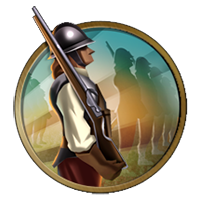
"The musket is a flintlock, muzzle-loading, long-barreled weapon which is fired from the shoulder. Muskets were lighter and more accurate than the earlier military firearm, the arquebus, and by the 18th century they had supplanted them on most European battlefields. With the addition of a bayonet the musket became a serviceable close-combat weapon as well, rendering the pikeman obsolete. The British army's "Brown Bess" was the archetypical musket, in service from 1722 until 1838; it was used by both sides in the American Revolution."
- Musketman's Civilopedia entry
But more importantly is the gameplay reason: the musket is an upgrade to the Longsword, which is an advanced iron-based infantry unit. But the musket is the default infantry unit of its era and doesn't require a resource. What is the default infantry unit of the classical and medieval eras? The spearman and the pikeman. They don't require resources, so they are the most common units of those eras, and will likely make up the backbone of most civs' armies. But then they all upgrade into a very niche anti-mounted unit that is definitely not the backbone of any army. I know that the spear and pike have anti-mounted attributes, so it makes sense that they upgrade to an anti-mounted unit, but they are also the default resourceless infantry, so they should remain that way when upgraded!
This can be especially crippling for civs that are handicapped by a lack of strategic resources and / or low production. These civs probably aren't on the warpath anyway, since they can't afford to build and maintain a large enough army for conquest. But now their primary defense unit (the Pikeman) becomes obsolete, and they don't have the horses necessary to upgrade it. And if they lack iron and couldn't build swords, then they have to build a new defensive army of Muskets from scratch! And remember, this is hypothetical civilization is already at a production and military disadvantage. Talk about the rich getting richer...
It's an annoying contradiction that can't really be resolved without redesigning the unit upgrade paths and adding new units to fill the gaps. Personally, I think the solution would be for the pike to upgrade to the musket, the iron-requiring longsword to upgrade to a resource-requiring grenadier (or similar heavy infantry unit), and for the lancer to be the start of the anti-armor class - or heck, just make it an upgrade to the poor Chariot Archer!.
Or Firaxis can just allow the player to chose whether to upgrade his pike to a musket or lancer. That would solve a lot of problems too.
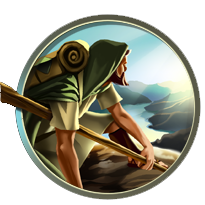
There are other annoyances with units and upgrade paths. Probably the most notable one is that Scouts lack an upgrade. They very quickly lose their value and become irrelevant to the game (assuming any survive barbarian attacks to begin with), even though most game maps have a second phase of exploration after Astronomy is researched. Having an improved Scout that doesn't die when a barbarian sneezes in his general direction would be very helpful for this phase of the game. But nope; you're best bet is generally to promote a Knight with Sentry and send him off exploring. So then why doesn't the Scout just upgrade to a Knight?
Excessive "Warmonger" hate
This one would have been number 2 or 3 on this list if the fall patch for Brave New World hadn't taken decent steps to address it. It's still a problem, but nowhere near as bad as it was earlier in the game's existence.
Put simply, early-game aggression would arbitrarily cause other civs to hate you. Forever! Capturing just one or two cities in the ancient or classical era could result in every civ in the game labeling you as a "warmonger" for the remainder of the game and refusing to trade with you, even if you haven't fought a single battle since. This effect was especially potent for aggression against city states.
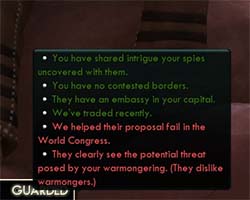
I fight some wars of aggression two thousand years ago, and the A.I. won't let it go.
In addition to being annoying, it also had the effect of crippling some entire civilizations whose abilities were based primarily around warfare. Assyria, the Huns, Mongolia, Zulu, and so on could have their abilities and uniques made completely moot by the inability to actually use them when they are available, unless you are already fully committed to a domination victory. If you achieve another victory, it would probably be an "accidental" victory as a result of weakening all other players to the point that you surpass them in science, culture, or city state influence by simple virtue of being a runaway superpower.
I'm very glad that patches have reduced the length of time that the A.I.s hold this warmonger grudge unless you continue to provoke it, but it can still be pretty extreme. A.I.s really shouldn't worry about warmongers unless they are habitually declaring war or have conquered several other civs. I know there needs to be some checks against runaway conquerors in order to maintain some degree of game balance, but this was not the way to do it.
Instead, disincentives for meaningless combat should be organically built into the game. Internal war weariness, poor morale among troops, national debt as a result of ballooning military costs, stagnant economy as a result of lack of trade partners, and coalitions against you by those who are vulnerable should be the costs of poorly-managed war; not some arbitrary diplomatic modifier.
Removing cinematics and other bells and whistles
In many ways, Civ V can be a very stale game from a production standpoint. sure it has lots of content, and the gameplay (with the two expansions) is great. But it's missing some of the bells and whistles of its predecessor.
The Baba Yetu music video featuring Civ IV and Colonization cinematics
and a sample of some wonder construction videos.
One of the things that makes Civ IV so great is that its production values were through the roof. From the Grammy-award winning (and for me, nostalgic-tear-inducing) title song Baba Yetu (composed by Christopher Tin), to the brief history of life on Earth narrated by Leonard Nimoy (may he rest long and prosper), to the gorgeous wonder-building cinematics, all the way to the end-game cutscenes, Civilization IV was constantly delighting the senses at the same time that it stimulated the mind and engaged the player with its fantastic strategic depth.
And the audio and visual production didn't end with cinematics. The whole game world felt more alive and dynamic due to visual cues that were often informative as well as immersive. Disturbed flocks of birds would fly out of the trees when a unit would enter a forest or jungle. Every building had a 3-D model that could be seen in the city on the world map, showing the player exactly what infrastructure the city possesses. Tile improvements have different graphics and animations indicating they are worked: a worked mine would have animated mine carts going in and out of the shaft; even an unimproved tile would have a little hut appear to indicate that it was being worked. All of this combined to provide a sense of immediate feedback about the world (from a mechanical standpoint), as well as provide a sense that the world is a living place.
Civ V's more satellite-realism approach looks fine in static images, but it grows stale and boring in motion. Watching two foxes frolic in the woods just isn't as meaningful as knowing that the city you're about to attack is working a high-production iron mine and could pop new units at any time, or that it contains barracks that means any units it does produce will be promoted. I'd take Civ IV's cartoonish, but immersive and informative, graphics over Civ V's satellite photo graphics any day! But there's no reason why there couldn't have been compromise between the two.
Civ IV's opening cinematic, featuring a brief history of life on Earth narrated by the late Leonard Nimoy
Overall, Civ V doesn't have this same artistic flourish of sight and sound. The only step-up in production value is the spoken dialogue from the leaders, which is still extremely limited and lacks any sense of talking to a real person. The intro narration for each civilization is fine, but the static image and simple text could use a little more pzazz. Brave New World did help to bridge the gap with the music, art work, and snippets of literature that was included in its great works, but that still didn't have the same oomph as the wonder videos of Civ IV.
For an expensive, triple-A title from a major publisher, I expected a little bit more out of Civ V.
Linear, rigid tech tree
I love Civ IV's tech tree! While it may have been a bit difficult for some players to read, it made up for this useability issue by being immensely flexible. Techs had different optional requirements that allowed players to follow the paths that offer the most utility. You weren't forced to research naval techs for your land-locked, pangea civilization in order to gain access to valuable cultural and educational buildings. On top of that, a lot of the flow of the technologies just made sense! It was easy to see how one technology would lead to the development of another.
Civ V took all of that away. The tech tree is a much more linear progression, and players are more often forced to research useless techs in order get to things that they need. Why do I need to have researched Sailing and Navigation in order to eventually get to Biology and build hospitals? Especially if I'm in the middle of a pangea or a map that doesn't even have oceans!
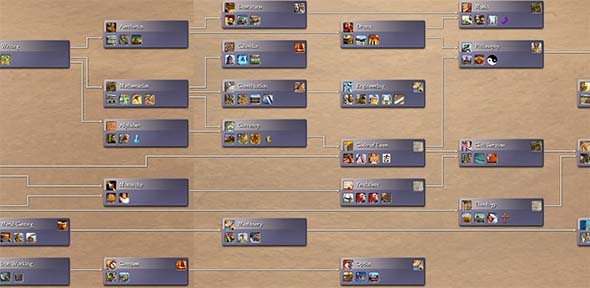
I can get to Civil Service through Code of Law or Feudalism, as long as I've researched Mathematics.
On top of that, some of the tech progressions just don't make much sense, since paths had to be adjusted based on unit placements and in order to make the tree itself look pretty. Why do I need to learn to shoot a bow and arrow in order to invent the wheel? Mechanically, it is because The Wheel unlocks the Chariot unit, which requires Archery, so roads require Archery too. I understand why Banking might require Guilds, but I don't get why it would also need Chivalry. How is it that I can construct the Internet without ever inventing the computer?
I do like that all the technologies unlock something that each civilization can actually use. Civ IV did have an annoying tendency to create technologies that unlocked nothing but world wonders (such as Aesthetics). So once those wonders have been built by other civs, that tech is completely useless to every other civilization. Fortunately, that mostly only happened on leaf techs that weren't necessary to progress. But Civ V did do a good job of avoiding this problem, even if some techs have very limited utility in some circumstances.
Constant snowballing
I guess this one isn't really unique to Civ V, but that game did bring it to the forefront a little bit with its more straightforward mechanics. When the vanilla game launched, every city produced an automatic 2 gold and 2 science. This gave huge advantages to civs and A.I.s that favored rapid city spam, since each new city provided linearly-incremental improvements with happiness being the only mechanic in place to prevent runaways. But if you built (or bought) a coloseum in every city and kept its population low, you could easily offset the happiness costs.
As the game received post-release patches and expansions, city spam became less encouraged. The static gold and science yield was removed from cities, forcing growth and infrastructure to be the source of any gains the city could provide. Happiness buildings were limited to only providing as much happiness as the city's population. National wonder and social policy cost was scaled up with more cities. And eventually, a science penalty was applied to expansive civilizations.

But even though it was neutered a bit, the underlying principle of "snowballing" is still firmly in place, such that I don't think an episode of PolyCast has been aired in the past few years in which the term wasn't spoken. It's just changed its nature from rampant city-spam (in Civ V vanilla) to more focused, powerful capitals and military advantages.
Snowballing is a concept based on a feedback loop in which small advantages early in the game compound as the game progresses, and become large advantages later. For example, every turn of extra production early means more cities and units being built sooner, which in turns allows for faster development and more effective conquest. And faster development and conquest, in turn, leads to unlocking more things that further speed up development.
The rich get richer faster than the poor can catch up, and the result is an imbalanced game.
The game has very few mechanics in place to allow for disadvantaged civs to catch up. And the mechanics that are in place to slow down runaways are only minimally effective. This all means that falling behind early is crippling, especially in competitive multiplayer. This leads to Diety and multiplayer game strategies requiring very rigid steps regardless of your civilization and circumstances (such as adopting Tradition and beelining to the National College). It also creates a lot of games ending prematurely when a player just gives up. And on the other side of the coin, it leads to a lot of decided games dragging on in the second half, since victory has been a foregone conclusion, and the player just needs to go through the motions and hit "End Turn" until a victory screen is displayed.
Forcing small-scale tactical combat onto a large-scale map
While the 1-upt combat mechanics are not an inherently bad design principle (in fact, it made my Top 10 list of good ideas), it did lead to many unfortunate consequences in the game's fundamental design. One of the most noticeable issues is with the game's scale in general. The designers took inspiration from hex-based tactical strategy games such as Panzer General. The problem with this is that Panzer General is a game about small-scale battle tactics; whereas, Civilization is a game about grand-scale strategy.
The end result is that there is an uncomfortable juxtaposition of the two paradigms present in Civ V. On one hand, you're moving individual units around a battlefield, moving formations, performing flanking maneuvers, conducting bombardment, and so on. On the other hand, you're also building and growing cities across a continent. And both of these are the same map! So a single catapult takes up the same area as a city, and armies fill the entire land area of whole nations. Instead of obstacles like buildings, trees, or streams getting in the way of your formation maneuvers and tactical decisions; entire cities, whole forests, and oceans are battlefield obstacles that your units have to navigate. Sieges of a single city often spill over into neighboring cities, and naval blockades fill entire seas.
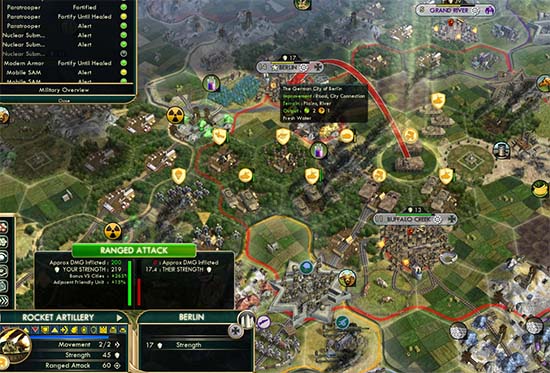
The tactical combat conflicts with the nation-state scale of the map.
I understand that the scale is supposed to be abstracted, but this is really pushing the boundaries. It also creates numerous logistical issues as well. For example, rich nations with massive populations that occupy only a small land area cannot support large armies because they simply run out of room in their country for all those troops to stand.
This leads to "carpet of doom" problem late in the game, in which the map becomes full of units such that none can move. It also causes problems earlier in the game. Since the map is at such a large scale, there is a significant lack of open space in which to move and maneuver armies. This considerably slows down movement across the map, and negates much of the usefulness of roads and railroads, since you often can't fit all your units on your roads anyway. If it were just a matter of the roads not being big enough, and more resources needed to be devoted to infrastructure, then that would be an element of strategy and planning. But the problem is strictly an issue with scale. Short of building a road on every tile (which the game actively discourages with maintenance costs), there is never enough road to move large armies across your territory.
Don't tell me you've never conquered an enemy, and then (instead of celebrating victory) you sigh with anguish at the thought of having to move all your units across the continent to your next target of conquest.
So while combat itself can be fun and tactical, the acts of mobilizing the units before the war, and cleaning up after the fight, can be painfully tedious processes that kill the pace of the game.
And why, why, why can't civilian units move through friendly units?! Stupid city states need to stop asking me to build a road and then block all their damn tiles with their own units!
No support for mods in multiplayer
This is a great way to shorten a game's lifespan. As the game gets older, most players will move on to other games (or sequels). The few that remain will likely be competitive multiplayers and / or people who look to expand the game experience through mods.
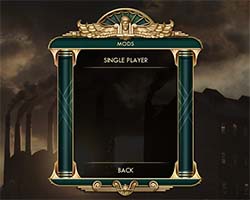
Mods can only be used for single player games.
Not being able to play mods in multiplayer really kills the game for players that want to play the game online, but are used to playing with mods. Even simple (yet excellent) interface mods like Rob K's Info Addict can't be played in MP (at least not without directly modifying game files yourself). It doesn't change any actual gameplay mechanics (as far as I know); it only adds improvements to the interface that make it easier to gather information and control your empire. Playing with such a useful mod can make it very difficult to go back to the unmodded game.
I understand that supporting mods in MP can be a technical challenge. You need to make sure that all players have the same mod(s) installed. But it's possible. Civ IV did it; although, that game did suffer from frequent issues in which the game becomes un-synced. Heck, Civ V doesn't even support mods in Hot Seat mode! There is no technical issue with that because all players are playing the game off of the same computer and the same game instance.
When Brave New World failed to include mod support in multiplayer, I kind of gave up on working on my own large-scale mods. I still hope to finish them at some point, but not being able to play them with my friends makes me much less eager to finish them.
And while we're on the topic of multiplayer, why don't notifications work correctly for multiplayer? And why didn't Firaxis add notifications for events that would normally [in single player] take you to another screen (like meeting another player takes you to the diplo screen)? It's very easy to miss these events in multiplayer.
These are examples of things that could be easily modded to improve the multiplayer experience. But since multiplayer doesn't support mods, that isn't happening.
Focus on a "strategy board game" rather than empire management sim
As I've mentioned earlier in this post, the shift towards hexes and 1-upt resulted in a simplification of a lot of other game elements. A lot of the "simulation" aspects of the game were removed or abstracted significantly. This included the game's economy, government management, the tech tree, religion, and so on. Many of these areas were re-expanded by expansions and DLC, and the current game is much more complex and robust.
But the end result is that Civ V feels much less like an empire management game, and more like a computerized board game. A lot of the feeling of being a world leader in charge of a civilization full of people was lost, and the ability to role play was diminished. With the scaling issues, simplifications of management mechanics, and emphasis on combat, cities stopped feeling like cities, and started feeling like watchtowers or barracks. It all combines to make the game feel more like a war game (akin to a complicated version of Risk or Axis & Allies) rather than a game of "civilization".
Perhaps the most noticeable area in which empire management has lost focus is in the abstraction of global happiness (as opposed to Civ IV's city-based happiness). This change mitigates the desire to build expansive empires (at least once the automatic 2 gold and science from newly-founded cities was removed). New cities and conquests cause universal unhappiness, and luxury resources have a global effect, so there is no need or incentive to build new cities to acquire profitable resource tiles, since it will only drag down your global happiness. This is a funny design choice considering that the designers added granularity to the strategic resources, but then stripped away complexity from the luxury and bonus resources. Having buildings that buff local resources near a city is a decent post-hoc compromise, but it still doesn't provide enough reward for settling new cities that do not provide access to previously-unconnected luxuries.
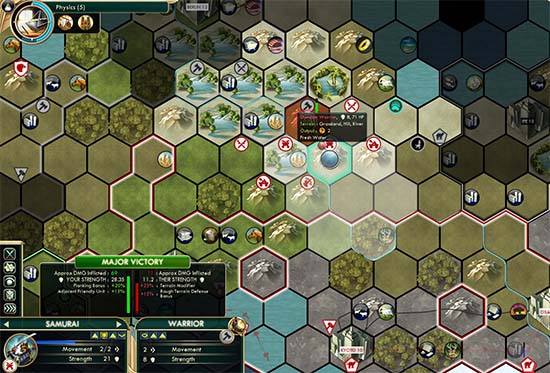
Civ V feels less like an empire-management sim, and more like a computerized war board game.
War may be the favorite topic of most history classes because they are easy to put on tests. They have defined start dates, end dates, battles, generals, and a definite winner and loser (usually). But the real history of human civilization isn't only a history of war and technological advancement. It's a history of interactions between people and groups of people. It's a history of trade and economics. It's a history of governments, laws, and taxes. It's a history of philosophies, ideologies, and religions. And it's a history of how humans affect the world around us. Civilization V in its vanilla form (much moreso than earlier iterations of the series) just missed all of that. It doesn't mimic the subtle sequences of cause and effect that shape human history. And it took two whole expansions before the game seemed to finally start to be a game of "civilization", rather than a game of "Risk through the ages".
Did I miss any aspects of the game that really get on your nerves? Think the designers totally botched something that I didn't talk about? Am I dissing one of your own favorite features? Then feel free to comment!
Join the discussion on Civfanatics:
http://forums.civfanatics.com/showthread.php?p=13854439#post13854439
Listen to the discussion on PolyCast, Episode 236, 18m47s (August 29, 2015):
http://civcomm.civfanatics.com/polycast/polycast/season9/episode236.mp3
And don't forget to check out my list of Top 10 good ideas.
47a0e2f2-1d86-4631-864b-65698442a29f|1|5.0
Tags:Sid Meier's Civilization, civilization, Civilization V: Brave New World, retrospective, Civilization V: Gods & Kings, raze, capitals, insta-heal, lancer, chariot archer, scout, warmonger, tactics, Civilization V
|

| 12 | | | | | | | 60 | | 11 | | | | | | | 55 | | 10 | | | | | | | 50 | | 09 | | | | | | | 45 | | 08 | | | | | | | 40 | | 07 | | | | | | | 35 | | 06 | | | | | | | 30 | | 05 | | | | | | | 25 | | 04 | | | | | | | 20 | | 03 | | | | | | | 15 | | 02 | | | | | | | 10 | | 01 | | | | | | | 05 |
|